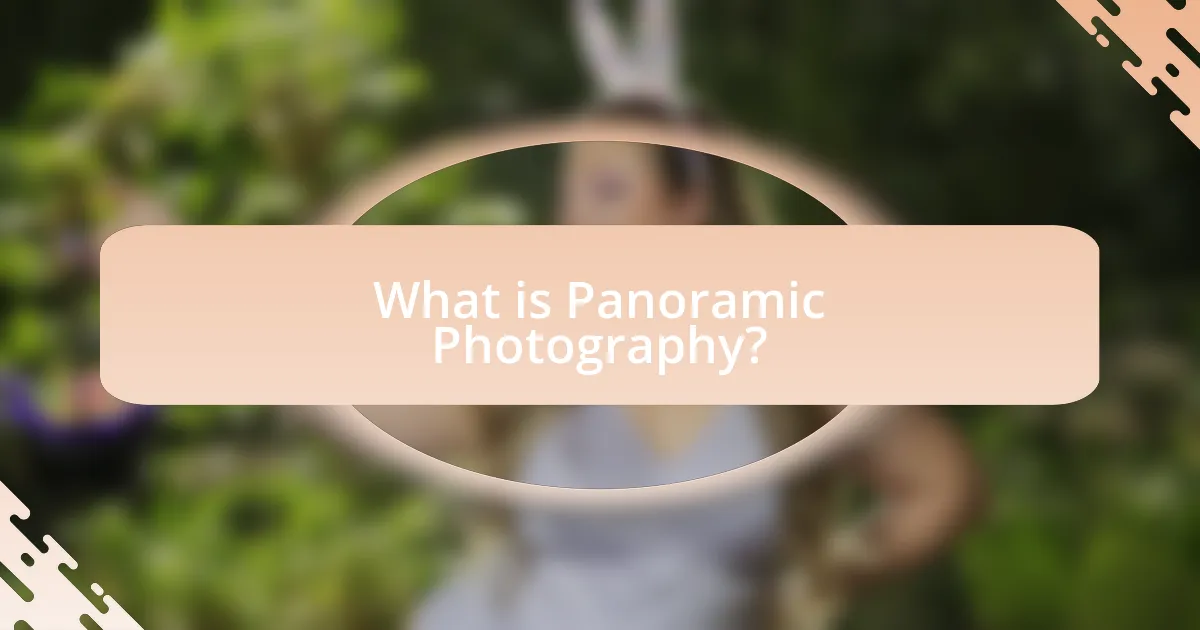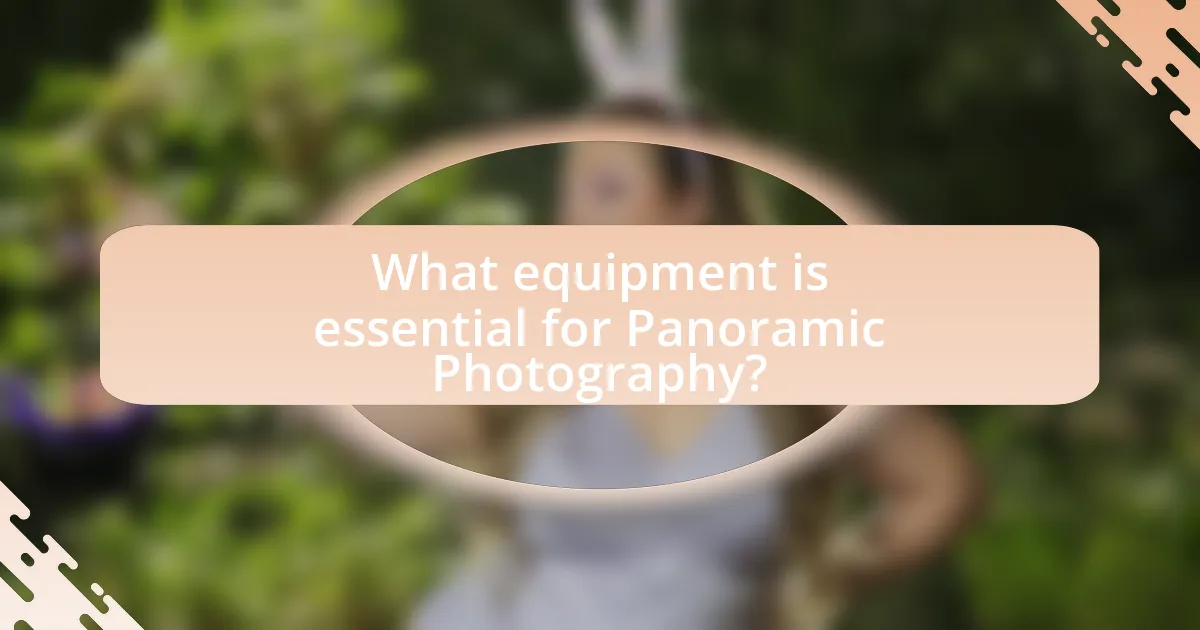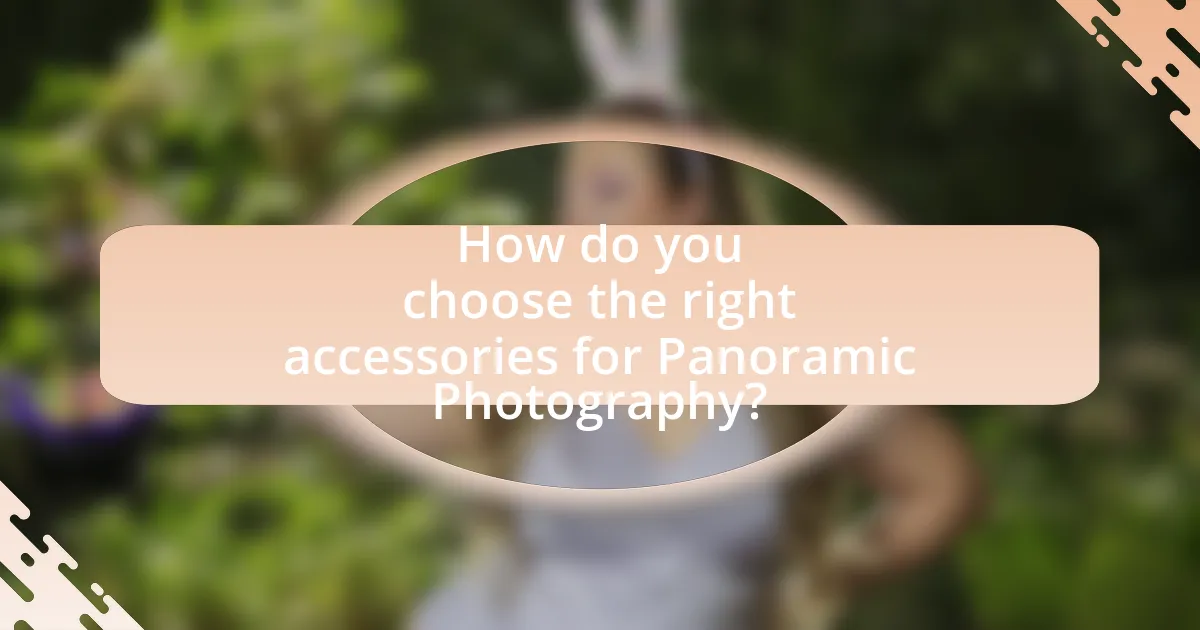Panoramic photography is a specialized technique that captures images with an extended field of view, often exceeding 180 degrees, allowing for immersive landscapes and cityscapes. This article explores the essential equipment and techniques required for successful panoramic photography, including the importance of using wide-angle lenses, tripods, and panoramic heads. It also discusses the significance of composition, the impact of camera types and sensor sizes, and the role of software in stitching images together. Additionally, practical tips for achieving high-quality panoramic images are provided, making this a comprehensive guide for photographers interested in enhancing their panoramic photography skills.

What is Panoramic Photography?
Panoramic photography is a technique that captures images with an elongated field of view, typically exceeding the standard 180 degrees. This method allows photographers to create wide-angle images that encompass a broader perspective than traditional photography, often resulting in immersive landscapes or cityscapes. The technique can be achieved through specialized panoramic cameras, software stitching of multiple images, or using wide-angle lenses. The effectiveness of panoramic photography is evidenced by its widespread use in various fields, including real estate, tourism, and virtual reality, where expansive views enhance visual storytelling.
How does Panoramic Photography differ from traditional photography?
Panoramic photography differs from traditional photography primarily in its ability to capture a wider field of view, often exceeding 180 degrees. Traditional photography typically focuses on a single frame that encompasses a limited perspective, while panoramic photography stitches together multiple images or uses specialized equipment to create a seamless, expansive image. This technique allows for the representation of vast landscapes or large group scenes that would not fit within the confines of a standard photograph. The use of panoramic formats has been supported by advancements in camera technology and software, enabling photographers to produce high-resolution images that maintain detail across the extended view.
What techniques are used in Panoramic Photography?
Panoramic photography employs several techniques to capture wide-angle images. One primary technique is the use of a tripod to stabilize the camera during a series of overlapping shots, ensuring consistent alignment and exposure. Another technique involves using a panoramic head, which allows for precise rotation around the camera’s nodal point, minimizing parallax errors. Additionally, software stitching is commonly used to combine multiple images into a single panoramic photograph, enhancing the final image’s resolution and detail. These techniques collectively enable photographers to create expansive and immersive landscapes that traditional photography cannot achieve.
Why is composition important in Panoramic Photography?
Composition is crucial in panoramic photography because it determines how effectively the viewer engages with the expansive scene. A well-composed panoramic image guides the viewer’s eye through the landscape, creating a sense of depth and context. For instance, the rule of thirds can enhance visual interest by placing key elements along intersecting lines, which is particularly important in wide-format images where balance is essential. Additionally, effective composition can help avoid distractions and ensure that the main subject stands out, thereby enhancing the overall impact of the photograph.
What are the key benefits of Panoramic Photography?
The key benefits of panoramic photography include the ability to capture wide scenes, enhance visual storytelling, and create immersive experiences. Panoramic photography allows photographers to encompass a broader field of view than traditional photography, making it ideal for landscapes, cityscapes, and large group shots. This technique can convey a sense of scale and depth that standard images may lack. Additionally, panoramic images can engage viewers more effectively, drawing them into the scene and providing a more comprehensive perspective. Studies have shown that immersive visuals can increase viewer engagement and retention, making panoramic photography a valuable tool for both artistic expression and commercial applications.
How does Panoramic Photography enhance storytelling in images?
Panoramic photography enhances storytelling in images by capturing a wider field of view, allowing for a more immersive experience. This technique enables photographers to convey the context and scale of a scene, which is crucial for storytelling. For instance, a panoramic image of a landscape can illustrate the vastness of a location, providing viewers with a sense of place that standard photographs may lack. Additionally, panoramic photography can integrate multiple elements within a single frame, such as foreground, midground, and background details, which collectively contribute to a richer narrative. Studies have shown that images with broader perspectives can evoke stronger emotional responses, thereby enhancing the overall impact of the story being told.
What types of scenes are best suited for Panoramic Photography?
Panoramic photography is best suited for expansive landscapes, city skylines, and large group portraits. These scenes benefit from the wide field of view that panoramic techniques provide, allowing for a more immersive representation of the environment. For instance, landscapes such as mountains, beaches, and valleys can capture the vastness and beauty of nature, while city skylines can showcase the architectural diversity and scale of urban settings. Additionally, large group portraits can effectively include all subjects in a single frame without distortion, making panoramic photography ideal for events.

What equipment is essential for Panoramic Photography?
Essential equipment for panoramic photography includes a camera with a wide-angle lens, a sturdy tripod, and a panoramic head. A camera with a wide-angle lens allows for capturing expansive scenes, while a sturdy tripod ensures stability during the shooting process, reducing motion blur. A panoramic head is crucial for achieving precise alignment and consistent overlap between images, which is necessary for seamless stitching in post-processing. These components collectively enhance the quality and effectiveness of panoramic photography.
How do camera types affect Panoramic Photography?
Camera types significantly affect panoramic photography by influencing image quality, field of view, and stitching capabilities. For instance, DSLR and mirrorless cameras typically offer larger sensors and interchangeable lenses, which enhance image resolution and dynamic range, crucial for capturing expansive scenes. In contrast, compact cameras may have limited sensor size and fixed lenses, potentially resulting in lower image quality and narrower field of view. Additionally, specialized panoramic cameras, such as those with rotating heads or built-in stitching software, streamline the process of capturing and merging multiple images, reducing the likelihood of errors in alignment and exposure. Thus, the choice of camera directly impacts the effectiveness and quality of panoramic photography.
What features should you look for in a camera for Panoramic Photography?
For panoramic photography, you should look for a camera with a high resolution, wide-angle lens, and image stabilization. High resolution is crucial as it allows for detailed images when stitching multiple photos together, with cameras offering at least 20 megapixels being ideal. A wide-angle lens enables capturing more of the scene in a single shot, which is essential for expansive landscapes. Image stabilization helps reduce blurriness caused by camera movement, ensuring sharper images, especially in handheld shooting scenarios. These features collectively enhance the quality and effectiveness of panoramic photography.
Why is sensor size important in Panoramic Photography?
Sensor size is important in panoramic photography because it directly affects image quality, depth of field, and the ability to capture wide scenes without distortion. Larger sensors, such as full-frame sensors, provide better low-light performance and dynamic range, allowing for more detail and color accuracy in expansive landscapes. For instance, a study by DxOMark shows that full-frame sensors outperform crop sensors in terms of noise levels and tonal range, which is crucial for the high-resolution images typically desired in panoramic photography. Additionally, larger sensors can capture a wider field of view, reducing the need for excessive stitching of multiple images, which can lead to alignment issues and loss of detail.
What lenses are best for capturing panoramic images?
Wide-angle lenses are best for capturing panoramic images. These lenses typically have a focal length of 24mm or less, allowing for a broader field of view, which is essential for encompassing expansive landscapes or cityscapes in a single frame. Additionally, ultra-wide-angle lenses, such as those with focal lengths around 14mm to 16mm, can further enhance the panoramic effect by exaggerating depth and perspective, making scenes appear more immersive. The effectiveness of wide-angle lenses in panoramic photography is supported by their ability to minimize distortion and maintain image quality across the frame, which is crucial for stitching multiple images together seamlessly.
How do focal lengths influence the panoramic effect?
Focal lengths significantly influence the panoramic effect by determining the field of view and perspective in panoramic photography. A shorter focal length, such as 24mm, captures a wider field of view, allowing more of the scene to be included in the frame, which enhances the immersive quality of the panorama. Conversely, a longer focal length, like 85mm, narrows the field of view, compressing the scene and potentially losing the expansive feel typical of panoramic images. This relationship is supported by the principles of optics, where focal length directly affects the angle of view; for instance, a 24mm lens offers approximately 84 degrees of view, while an 85mm lens provides around 28 degrees. Thus, the choice of focal length is crucial in achieving the desired panoramic effect.
What are the advantages of using wide-angle lenses in Panoramic Photography?
Wide-angle lenses offer significant advantages in panoramic photography by capturing a broader field of view, which is essential for encompassing expansive landscapes or cityscapes. These lenses typically have a focal length of less than 35mm, allowing photographers to include more elements in a single frame without the need for extensive stitching of multiple images. This capability reduces the risk of distortion and misalignment that can occur when combining several images. Additionally, wide-angle lenses enhance depth perception, making foreground subjects appear more prominent while still including vast backgrounds, which is crucial for creating immersive panoramic images.

How do you choose the right accessories for Panoramic Photography?
To choose the right accessories for panoramic photography, prioritize a sturdy tripod, a panoramic head, and a wide-angle lens. A sturdy tripod ensures stability during long exposures, which is crucial for capturing sharp images in panoramic shots. A panoramic head allows for precise rotation and alignment of the camera, minimizing parallax errors that can distort the final image. A wide-angle lens is essential for capturing expansive scenes, as it enables a broader field of view, which is necessary for effective panoramic compositions. These accessories collectively enhance the quality and accuracy of panoramic photography.
What tripods are suitable for Panoramic Photography?
Tripods suitable for panoramic photography include those with a panoramic head, sturdy construction, and adjustable height. A panoramic head allows for precise rotation around the camera’s nodal point, minimizing parallax errors during image stitching. Models like the Manfrotto 405 Geared Head and the Really Right Stuff PG-02 are specifically designed for this purpose, providing stability and accuracy. Additionally, tripods such as the Gitzo Series 3 and Benro Mach3 are known for their durability and ability to support heavy camera setups, which is essential for capturing high-quality panoramic images.
Why is stability crucial when shooting panoramas?
Stability is crucial when shooting panoramas because it ensures that each individual image aligns perfectly, resulting in a seamless final composition. When a camera is stable, it minimizes unwanted movement that can lead to misalignment between frames, which is essential for creating a coherent panoramic image. Research indicates that even slight shifts can cause noticeable stitching errors, making stability a key factor in achieving high-quality panoramas.
What features should a tripod have for panoramic shots?
A tripod for panoramic shots should have a panoramic head, adjustable height, and stability features. A panoramic head allows for smooth, level rotation, essential for capturing wide images without distortion. Adjustable height enables photographers to achieve the desired perspective and composition, while stability features, such as a sturdy build and rubber feet, prevent camera shake and ensure sharp images. These characteristics are crucial for achieving high-quality panoramic photographs, as they facilitate precise alignment and consistent framing across multiple shots.
How can software enhance your Panoramic Photography experience?
Software enhances your panoramic photography experience by providing advanced stitching algorithms that seamlessly combine multiple images into a single panoramic shot. These algorithms, such as those found in software like Adobe Photoshop and PTGui, analyze overlapping areas of images to ensure precise alignment and blending, resulting in high-quality panoramas without visible seams. Additionally, software offers tools for correcting lens distortion and adjusting exposure, which further improves the final image quality. For instance, a study by the International Journal of Computer Vision highlights that effective stitching can increase the perceived resolution of panoramic images by up to 30%, demonstrating the significant impact of software on the overall photographic outcome.
What software options are available for stitching panoramic images?
Software options available for stitching panoramic images include Adobe Photoshop, PTGui, Hugin, and Microsoft Image Composite Editor. Adobe Photoshop offers advanced features for image manipulation and stitching, making it a popular choice among professionals. PTGui is known for its speed and ability to handle large image files, while Hugin is an open-source alternative that provides extensive customization options. Microsoft Image Composite Editor is user-friendly and free, suitable for beginners. Each of these software options has unique features that cater to different user needs in panoramic photography.
How does post-processing improve the final panoramic image?
Post-processing enhances the final panoramic image by correcting distortions, improving color accuracy, and increasing overall sharpness. These adjustments address common issues such as stitching errors and exposure inconsistencies that can occur during the initial capture. For instance, software tools can seamlessly blend overlapping images, ensuring a cohesive look, while also allowing for adjustments in brightness and contrast to achieve a more vibrant result. Additionally, techniques like noise reduction and sharpening can significantly enhance image clarity, making the final product more visually appealing.
What are some practical tips for successful Panoramic Photography?
To achieve successful panoramic photography, use a tripod to ensure stability and consistency in your shots. A tripod minimizes camera shake, which is crucial for capturing multiple images that will be stitched together seamlessly. Additionally, set your camera to manual mode to maintain consistent exposure settings across all images, preventing variations in brightness and color. Use a wide-angle lens to capture more of the scene, and overlap each shot by about 30% to facilitate easier stitching in post-processing. Finally, utilize panoramic stitching software, such as Adobe Lightroom or PTGui, to combine your images effectively, ensuring that the final result is a cohesive and high-quality panorama.